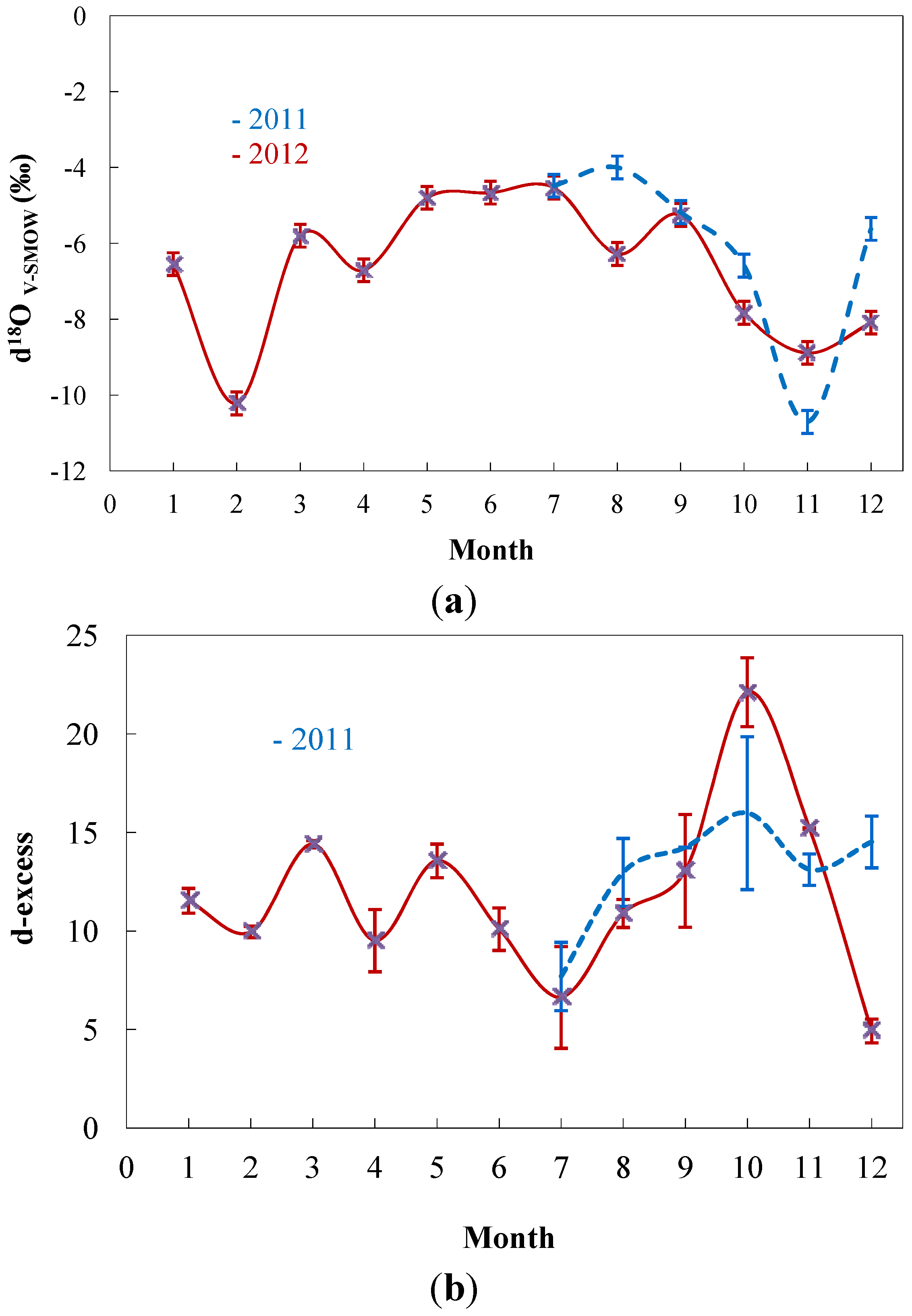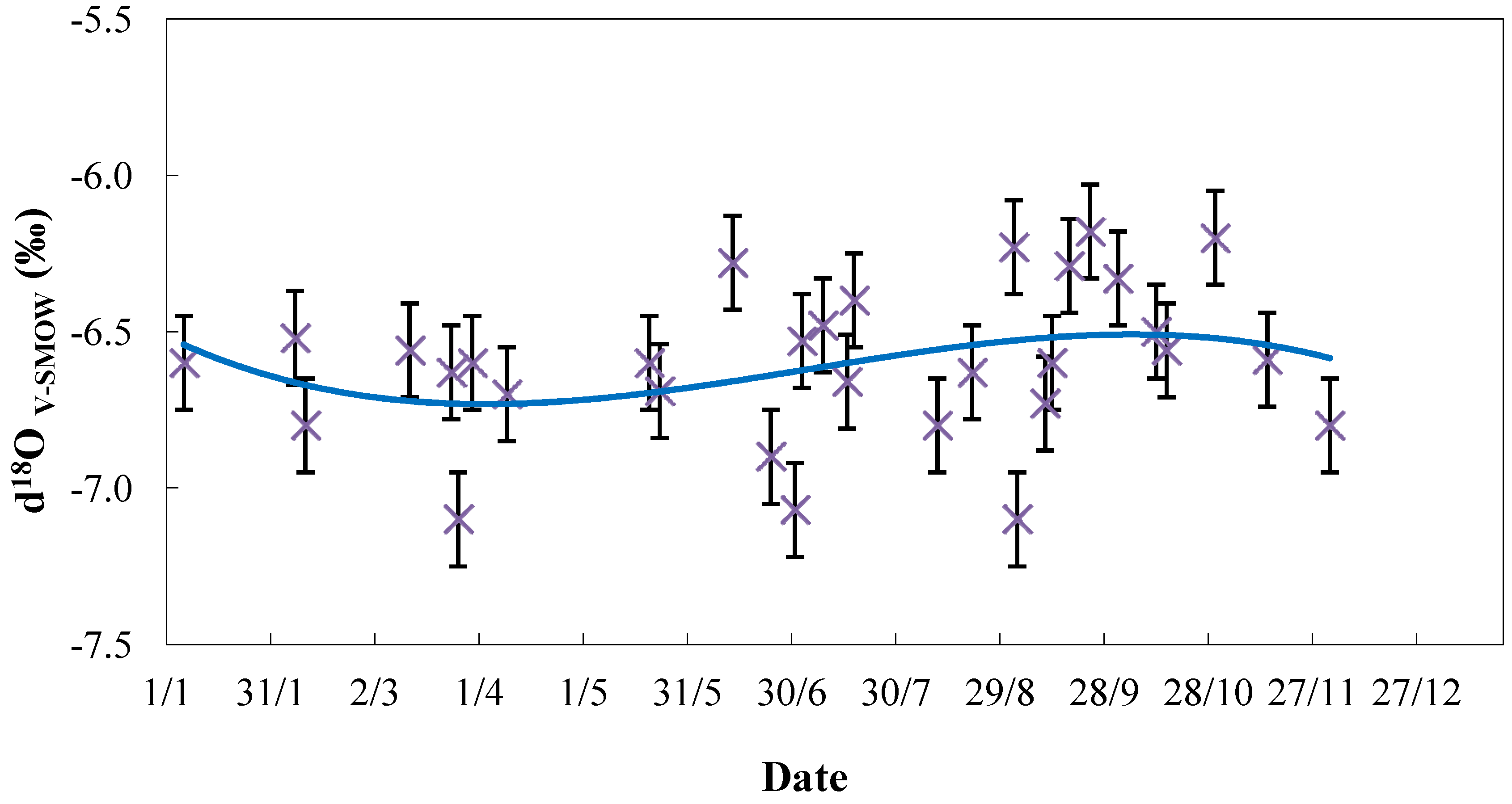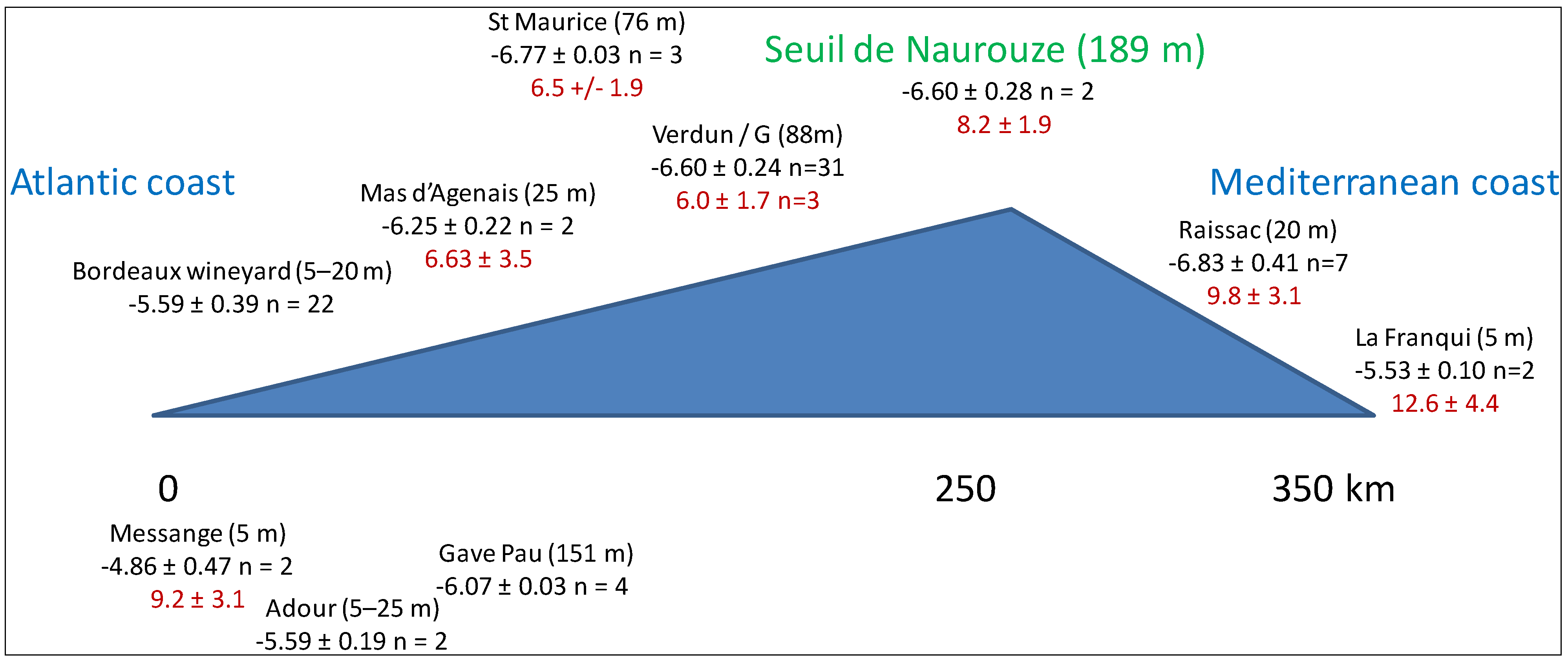Air Masses Origin and Isotopic Tracers: A Study Case of the Oceanic and Mediterranean Rainfall Southwest of France
Abstract
:1. Introduction
2. Experimental Section
2.1. Study Area

2.2. Rainfall Sampling
2.3. Groundwater Sampling
2.4. Isotopic Measurements
3. Results and Discussion
3.1. Rainfall Results
| Month | δ18O | δ2H | d-excess | Rainfall | Min. T | Max. T |
|---|---|---|---|---|---|---|
| (‰) | (‰) | (mm) | (°C) | (°C) | ||
| July 2011 | −4.48 | −28.15 | 7.69 | 86.5 | 14.9 | 25.7 |
| August 2011 | −4.00 | −19.02 | 12.98 | 21.5 | 16.3 | 29.0 |
| September 2011 | −5.18 | −27.18 | 14.24 | 73.5 | 14.8 | 27.2 |
| October 2011 | −6.59 | −36.73 | 15.98 | 24.5 | 9.6 | 21.7 |
| November 2011 | −10.71 | −72.56 | 13.12 | 31.0 | 9.6 | 15.9 |
| December 2011 | −5.62 | −30.45 | 14.51 | 53.0 | 5.0 | 12.1 |
| January 2012 | −6.55 | −40.87 | 11.53 | 39.0 | 3.8 | 10.3 |
| February 2012 | −10.22 | −71.81 | 9.95 | 4.0 | −2.5 | 6.0 |
| March 2012 | −5.80 | −32.00 | 14.40 | 22.0 | 4.1 | 17.5 |
| April 2012 | −6.71 | −44.17 | 9.51 | 69.0 | 7.6 | 16.2 |
| May 2012 | −4.80 | −24.84 | 13.56 | 75.5 | 11.6 | 22.2 |
| June 2012 | −4.67 | −27.23 | 10.10 | 53.5 | 15.0 | 26.5 |
| July 2012 | −4.53 | −29.61 | 6.63 | 58.0 | 14.7 | 27.5 |
| August 2012 | −6.28 | −39.35 | 10.89 | 48.5 | 17.5 | 30.4 |
| September 2012 | −5.25 | −28.96 | 13.05 | 26.0 | 13.9 | 24.7 |
| October 2012 | −7.83 | −40.53 | 22.12 | 53.0 | 11 | 20.5 |
| November 2012 | −8.89 | −55.92 | 15.20 | 49.5 | 6.8 | 14 |
| December 2012 | −8.09 | −59.80 | 4.93 | 50.5 | 4.6 | 11.6 |


3.2. Groundwater Results
3.2.1. Reference Well

3.2.2. Groundwater between Atlantic and Mediterranean Coasts

3.3. Discussion
| City | Slope | d-excess | R2 | δ18Ow mean | d-excessw | δ18O range | Rainfall | Year |
|---|---|---|---|---|---|---|---|---|
| (‰) | (‰) | (mm) | ||||||
| Dax | 6.09 | 0.32 | 0.948 | −4.59 ± 0.95 | 9.71 ± 1.24 | −6.84–−2.25 | 1156 | 1999–2005 |
| Bordeaux | 6.90 | 3.90 | 0.925 | −5.69 ± 0.65 | 10.18 ± 0.32 | −7.16–−4.33 | 920 | 2007–2009 |
| Toulouse | 7.70 | 9.86 | 0.909 | −6.32 ± 0.25 | 11.76 ± 0.59 | −10.71–−4.00 | 548 | 2012 |
| Montpellier | 6.49 | 3.07 | 0.825 | −4.17 ± 0.14 | 9.07 ± 2.07 | −6.65–−1.79 | 595 | 1997–1998 |
| Avignon | 7.19 | 2.31 | 0.984 | −5.49 ± 1.20 | 7.39 ± 2.95 | −7.83–−2.23 | 619 | 1997–2009 |
4. Conclusions
Acknowledgments
References
- Rozanski, K.; Araguas-Araguas, L.; Gonfiantini, R. Isotopic patterns in modern global precipitation. In Climate Change in Continental Isotopic Records; Geophysical Monograph Series Volume 78; Swart, P.K., Lohmann, K.C., Mckenzie, J., Savin, S., Eds.; American Geophysical Union: Washington, DC, USA, 1993; pp. 1–36. [Google Scholar]
- Celle, H.; Daniel, M.; Mudry, J.; Blavoux, B. Signal pluie et traçage par les isotopes stables en Méditerranée occidentale: Exemple de la région avignonnaise (Sud-Est de la France) [in French]. C. R. d’Acad. Sci. Ser. IIA Earth Planet. Sci. 2000, 331, 647–650. [Google Scholar]
- Celle-Jeanton, H.; Travi, Y.; Blavoux, B. Isotopic typology of the precipitation in the Western Mediterranean region at three different time scales. Geophys. Res. Lett. 2001, 28, 1215–1218. [Google Scholar] [CrossRef]
- Ladouche, B.; Aquilina, L.; Dörfliger, N. Chemical and isotopic investigation of rainwater in Southern France (1996–2002): Potential use as input signal for karst functioning investigation. J. Hydrol. 2009, 367, 150–164. [Google Scholar] [CrossRef]
- Millot, R.; Petelet-Giraud, E.; Guerrot, C.; Négrel, Ph. Multi-isotopic composition (Li, B, D, O) of rainwaters in France: Origin and spatio-temporal characteristization. Appl. Geochem. 2010, 25, 1510–1524. [Google Scholar] [CrossRef]
- Howard, A.D.; Dietrich, W.E.; Seidl, M.A. Modeling fluvial erosion on regional to continental scales. J. Geophys. Res. Solid Earth 1994, 99, 13971–13986. [Google Scholar] [CrossRef]
- Lambs, L. Correlation of conductivity and stable isotope 18O for the assessment of water origin in river system. Chem. Geol. 2000, 164, 161–170. [Google Scholar] [CrossRef]
- Lambs, L. Interactions between groundwater and surface water at river banks and the confluence of rivers. J. Hydrol. 2004, 288, 312–326. [Google Scholar] [CrossRef] [Green Version]
- Craig, H. Isotopic variation in meteoric waters. Science 1961, 133, 1702–1703. [Google Scholar]
- Dansgaard, W. Stable isotopes in precipitation. Tellus 1964, 16, 436–468. [Google Scholar] [CrossRef]
- Word Meteorological Organization (WMO), Climatological Normals (CLINO) for the Period 1961–1990; Secretariat of the Word Meteorological Organization: Geneva, Switzerland, 1996.
- Stichler, W.; Herrmann, A. Application of Environmental Isotope Techniques in Water Balance Studies of Small Basins. In New Approaches in Water Balance Computations, Proceedings of the 18th General Assembly of the International Union of Geodesy and Geophysics, Hamburg, Germany, August 1983; IAHS Publication 148: Oxfordshire, UK; pp. 93–112.
- Geyh, M. Groundwater. In Environmental Isotopes in the Hydrological Cycle; Mook, W.G., Ed.; International Hydrological Programme: Paris, France; International Atomic Energy Agency: Vienna, Austria, 2000; Volume 4, pp. 1–193. [Google Scholar]
- Longinelli, A.; Selmo, E. Isotope geochemistry and the water cycle: A short review with special emphasis on Italy. Mem. Descr. Carta Geol. d’It. 2010, 90, 153–164. [Google Scholar]
- Bats-Landalle, G. Analyse Géomorphologique de la Plaine d’Inondation de la Garonne [in French]. Ph.D. Thesis, University of Toulouse, Toulouse, France, September 1998. [Google Scholar]
- Weisman, G.S.; Zhang, Y.; LaBolle, E.M.; Fogg, G.E. Dispersion of groundwater age in an alluvial aquifer system. Water Resour. Res. 2002, 38, 1–13. [Google Scholar]
- Negrel, Ph.; Petelet-Giraud, E. Isotopes in groundwater: Indicators of climate changes. Trends Anal. Chem. 2011, 30, 1279–1290. [Google Scholar] [CrossRef]
- Gat, J.R.; Carmi, I. Effect of Climate Changes on the Precipitation Patterns and Isotopic Composition of Water in a Climatic Transition Zone: Case of the Eastern Mediterranean Sea Area. In The Influence of Climate Change and Climatic Variability on the Hydrologic Regime and Water Resources, Proceedings of the Vancouver Symposium, Vancouver, Canada, 9–22 August 1987; IAHS Publication 168: Oxfordshire, UK; pp. 513–523.
- Von der Emde, K.; Bougeault, Ph. High resolution simulation of a flow past the Pyrenees. Meteorol. Atmos. Phys. 1997, 62, 1–8. [Google Scholar] [CrossRef]
- Benech, B.; Koffi, E.; Druilhet, A.; Durand, P. Dynamic characteristics of regional flows around the Pyrenees in view of the Pyrex experiment. J. Appl. Meteorol. 1998, 37, 32–51. [Google Scholar] [CrossRef]
- Aouzerats, B.; Tulet, P.; Pigean, G.; Masson, V.; Gomes, L. High resolution modeling of aerosol dispersion regimes during the Capitoul field experiment: From regional to local scale interactions. Atmos. Chem. Phys. Discuss. 2010, 10, 29569–29598. [Google Scholar] [CrossRef]
- International Atomic Energy Agency Web Page. International Atomic Energy Agency Web Page. Global Network of Isotopes in Precipitation. Available online: http://www-naweb.iaea.org/napc/ih/IHS_resources_gnip.html (accessed on 9 May 2013).
- Bowen, G.J. The Online Isotopes in Precipitation Calculator, Version 2.2; Available online: http://www.waterisotopes.org (accessed on 13 May 2013).
- Gat, J.R.; Klein, B.; Kushnir, Y.; Roether, W.; Wernli, H.; Yam, R.; Shemesh, A. Isotope composition of air moisture over the Mediterranean Sea: An index of the air-sea interaction pattern. Tellus 2003, 55, 953–965. [Google Scholar]
© 2013 by the authors; licensee MDPI, Basel, Switzerland. This article is an open access article distributed under the terms and conditions of the Creative Commons Attribution license (http://creativecommons.org/licenses/by/3.0/).
Share and Cite
Lambs, L.; Moussa, I.; Brunet, F. Air Masses Origin and Isotopic Tracers: A Study Case of the Oceanic and Mediterranean Rainfall Southwest of France. Water 2013, 5, 617-628. https://doi.org/10.3390/w5020617
Lambs L, Moussa I, Brunet F. Air Masses Origin and Isotopic Tracers: A Study Case of the Oceanic and Mediterranean Rainfall Southwest of France. Water. 2013; 5(2):617-628. https://doi.org/10.3390/w5020617
Chicago/Turabian StyleLambs, Luc, Issam Moussa, and Frederic Brunet. 2013. "Air Masses Origin and Isotopic Tracers: A Study Case of the Oceanic and Mediterranean Rainfall Southwest of France" Water 5, no. 2: 617-628. https://doi.org/10.3390/w5020617
APA StyleLambs, L., Moussa, I., & Brunet, F. (2013). Air Masses Origin and Isotopic Tracers: A Study Case of the Oceanic and Mediterranean Rainfall Southwest of France. Water, 5(2), 617-628. https://doi.org/10.3390/w5020617




